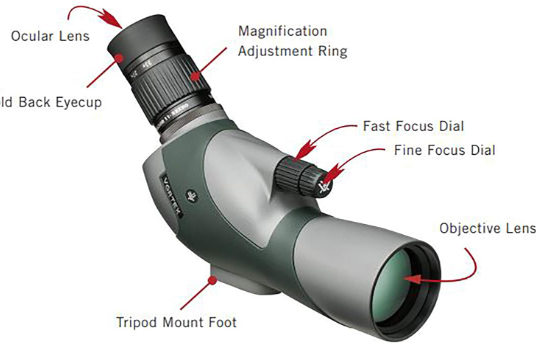Hello, this is our comprehensive analysis of the 6 Best Vortex Spotting Scopes For Astronomy. When it comes to astronomy, there are numerous types of telescopes and equipment with various applications. Each of them has its reason for being in an astronomer’s toolkit. We will analyze the top spotting scopes on the market and provide you with the necessary information so that you may select the best spotting scope depending on your tastes, demands, and, of course, money.
Stability is essential for detailed astronomical observations. Using a strong tripod and mounting method can reduce vibrations and improve the viewing experience. Spotting scopes are frequently more small and portable than larger telescopes, making them ideal for on-the-go studies.
When it comes to astronomy, The 6 Best Vortex Spotting Scopes For Astronomy have some disadvantages when compared to dedicated astronomical telescopes. Vortex Optics is well-known for providing high-quality optics. Look for features like completely multi-coated lenses to improve light transmission and image brightness.
6 Best Vortex Spotting Scopes For Astronomy
1. Vortex Optics Razor HD 27-60x85mm
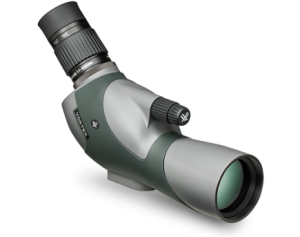
The Vortex Optics Razor HD 27-60×85 Spotting Scope has a 45° tilted viewing angle, excellent glass, and specific optical coatings to offer clear and brilliant images at all magnifications and lighting conditions. The triplet apochromatic lens is constructed of high-density (HD) extra-low dispersion (ED) glass to improve light transmission, reduce distortion, and almost eliminate chromatic aberration.
The lightweight and armored magnesium chassis is water and fogproof thanks to O-ring sealing and argon filling. Even when wearing gloves, a helical focus system with a broad adjustment collar allows for fast, yet precise focusing. The scope incorporates a tripod mounting shoe and a tripod collar that rotates to allow the eyepiece to be positioned for optimal viewing. A retractable lens shade reduces glare while keeping snow and rain away from the objective lens.
The objective lens diameter of 85mm denotes the size of the front lens. A bigger objective lens lets more light enter the scope, resulting in brighter images, especially in low-light circumstances.
The Razor HD has high-density, extra-low dispersion glass, which improves image quality and color integrity. This reduces chromatic aberration and produces images that are crisp, sharp, and true to life.
Specifications
- Dielectric prism coatings generate brilliant results.
- Triplet apochromatic (Apo) lens improves
- Traditional Porro prism optical path
- Extra low-dispersion (HD)
- Zoom magnification range: 27-60x
- 85mm objective lens
- Its high-density
- Extra-low dispersion glass for impressive image quality.
- Featured an angled eyepiece for comfortable viewing.
2. Vortex Optics Diamondback 20-60x60mm
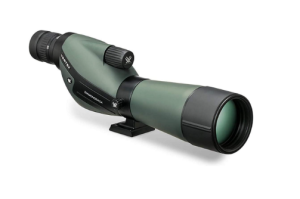
The adjustable eyepiece with a zoom capability allows users to modify the magnification within the defined range. It is probably equipped with a prism system, which is popular in spotting scopes to adjust image orientation and provide a more comfortable viewing experience.
Vortex Optics’ lenses often have anti-reflective coatings to improve light transmission and reduce glare. This is advantageous for obtaining crisp, bright photos. Vortex Optics frequently creates weather-resistant equipment with features such as fog-proofing and waterproofing. As a result, the spotting scope is suited for usage in a variety of environmental circumstances.
The building materials are most likely long-lasting and engineered to resist the rigors of outdoor use. The housing could be composed of aluminum or another lightweight yet strong material.
Spotting scopes are available in both angled and straight configurations. Models of the Diamondback series may be available in both configurations, allowing users to select based on their preferences.
Specifications
- Affordable option with a variable zoom eyepiece for versatility.
- Multi-coated lenses for bright and clear images.
- design their products to be weather-resistant
- Durable and designed to withstand the rigors of outdoor use
- Come in angled and straight designs
- Tripod adaptable for stable, extended use
3. Vortex Optics Viper HD 20-60x85mm
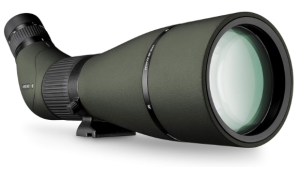
The “HD” in Viper HD stands for high density. The scope is outfitted with high-density extra-low dispersion (ED) glass elements, which serve to eliminate chromatic aberration and generate high-resolution, color-accurate images. The optics are fully multi-coated, which means that various anti-reflective coatings are applied to the air-to-glass interfaces. This improves light transmission, resulting in brighter visuals.
ArmorTek coating protects the outside lenses from scratches, grease, and dirt. The Viper HD spotting scope may be available in either an angled or straight body shape, depending on the model. The decision between the two is determined by personal preference and intended use.
The Viper HD offers a variable magnification range of 20x to 60x, allowing users to zoom in and examine distant things in detail. The objective lens diameter is 85mm. A bigger objective lens allows more light to enter the scope, resulting in brighter and clearer images, especially in low-light circumstances.
Specifications
- High-density
- Has a variable magnification range from 20x to 60x
- Objective lens diameter is 85mm
- ArmorTek coating to protect exterior lenses.
- High-density extra-low dispersion
- Fully multi-coated
4. Vortex Optics Razor HD 11-33x50mm
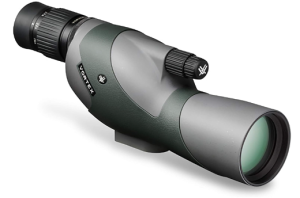
The spotting scope most likely has a Porro prism design, which is noted for its superb light transmission and depth perception. The lenses can be treated with Vortex’s patented ArmorTek coating, which protects against scratches, grease, and grime.
The Razor HD is most likely built to be waterproof and fogproof, allowing it to resist a variety of weather situations. This spotting scope may have an angled body design, which allows for more comfortable viewing, especially while studying objects at differing heights.
The spotting scope may incorporate a rotating tripod ring that enables for easy rotation and adjustment of the scope while placed on a tripod. The 50mm objective lens diameter and general design suggest that this spotting scope is compact and lightweight, making it perfect for portable use.
The spotting scope’s magnification range is variable, ranging from 11x to 33x, allowing users to zoom in on faraway objects for detailed study. The objective lens is 50mm in diameter. This value is significant because it dictates how much light the scope can gather, which affects image brightness and clarity, particularly in low-light circumstances.
Specifications
- Compact and lightweight design
- Porro prism design
- Waterproof and fog proof
- Ideal for both spotting and digiscoping.
5. Vortex Optics Viper HD 15-45x65mm
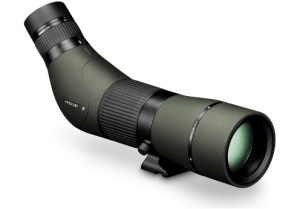
The 45° angled viewing Vortex Optics Viper HD 15-45×65 Spotting Scope is a great companion for mid-to long-range shooters and hunters, delivering brilliant and sharp high-contrast images with true-to-life color and crisp clarity at all magnifications, even in low or challenging light circumstances.
Image quality is improved by using anti-reflection completely multi-coated high-density (HD) extra-low dispersion (ED) glass elements in the lens system and highly reflective dielectric and phase-correcting coatings on the Porro prism system. These optical elements work together to maximize light transmission, increase color accuracy and contrast, and improve clarity and resolution over the whole zoom range.
The big 65mm objective increases the spotter’s light-gathering capabilities, keeping views bright and clear even in low-light settings and when viewing subjects at extreme distances at full magnification. The broad focus collar is easy to use in cold and rainy weather, and the helical focusing technique brings subjects into a tack-sharp resolution without turning the lens elements–maintaining precise optical alignment across the entire zoom and focus ranges.
Specifications
- Compact and lightweight
- Extra-low dispersion glass.
- ArmorTek coating
- Broad 15-45x fixed zoom eyepiece
- Twist-up rubber eyecup
- Long 19.6-17.8mm eye relief
6. Vortex Optics Diamondback 16-48x65mm
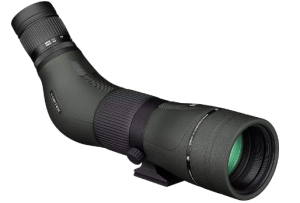
An excellent tool for mid-to long-range shooters and hunters, the Vortex Optics Diamondback HD 16-48×65 Spotting Scope has a 45° viewing angle and produces sharp, clear, high-contrast images at all magnifications, even in dim or difficult-to-light conditions.
Anti-reflection fully multicoated high-density (HD) extra-low dispersion (ED) glass components in the lens system promote light transmission, boost color fidelity and contrast, and enhance clarity and resolution throughout the zoom range, all of which contribute to improved image quality.
The big 65mm objective increases the spotter’s light-gathering capabilities, allowing it to maintain bright and crisp images even in low-light situations and when viewing subjects at long distances at maximum magnification.
The eyepiece on this Diamondback HD is placed 45° to the body to maximize viewing comfort whether you’re standing, sitting, or lying prone when gazing through it. A helical focus mechanism replaces the more conventional knob-based approach, offering smooth focusing without the snag hazard associated with knobs.
Specifications
- Compact and budget-friendly option.
- Fully multi-coated lenses
- Large Objective Lens
- Extra Low-Dispersion High-Density Glass
- Lens Coatings with Anti-Reflection & ArmorTek
- Argon-filled, water- and fog-resistant
- Collar with a Rotating Tripod
- Single-speed Helical Focuser
Read Also:
8 Best Celestron Spotting Scopes For Hunting
Factors to Consider when Choosing the 6 Best Vortex Spotting Scopes For Astronomy
Choosing the 6 Best Vortex Spotting Scopes For Astronomy entails taking into account several criteria to ensure that the scope suits your unique requirements and preferences. Here are some crucial considerations to think about.
Magnification
Consider the spotting scope’s magnification range. Excessive magnification can provide a darker image, especially in low-light situations. Look for a spotting scope with a good combination of magnification and brightness. Higher magnifications can be useful for studying features on the moon or planets, but too much magnification might result in a darker image and a restricted field of view.
Objective Lens
The objective lens’s quality is critical for image clarity and brightness. Spotting scopes with high-quality, completely multi-coated lenses that decrease glare and produce sharp, clear images should be considered.
Field of View
A larger field of view helps with locating and tracking astronomical objects. Consider purchasing a spotting scope with a huge field of view, especially if you intend to observe large areas of the night sky. A broader range of view is useful for locating and tracking astronomical objects. However, larger magnifications frequently result in a reduced field of view.
Weight
Consider the weight and portability of your spotting scope if you intend to transfer it to different observation sites. It is easier to carry and put up if it is lightweight and compact. Consider the size and weight of the spotting scope, particularly if you intend to move it regularly. Models that are small and lightweight are easy to transport.
Options for Mounting
Consider the many spotting scope mounting choices. Some variants include a spinning tripod mount that can be used to track astronomical objects. Make that the mounting system is solid and works with conventional tripods.
Durability
To ensure durability, make sure the spotting scope is made of high-quality materials. To defend against the elements, look for waterproof and fog-proof characteristics, as well as a sturdy structure that can resist outside situations.
6 Best Vortex Spotting Scopes For Astronomy FAQs
- Are Vortex spotting scopes useful for astrophotography?
Spotting scopes, particularly those made by Vortex, are primarily intended for visual observation. While some models may allow you to attach a camera, they may not be the greatest choice for professional astrophotography. Dedicated astrophotography equipment, such as telescopes with tracking mounts, is usually recommended.
- Can I use Vortex spotting scopes for terrestrial observation as well?
Yes, Vortex spotting scopes are versatile and can be used for both terrestrial and celestial observation. Some models may have features such as angled eyepieces, which can be useful for both forms of viewing.
- What is a spotting scope, and how does it vary from a telescope?
A spotting scope is a small, portable telescope used for terrestrial observations such as bird watching, wildlife observation, and, in certain situations, astronomy. Spotting scopes have lesser magnification than telescopes and are frequently used for daytime activities.
- Can you use a spotting scope for astronomy?
Yes, some spotting scopes are appropriate for astronomy, particularly for terrestrial objects such as the Moon and planets. They may not, however, be as powerful or specialized as specialist astronomical telescopes.
Conclusion
The 6 Best Vortex Spotting Scopes For Astronomy are an excellent choice for astronomers, with a variety of alternatives to meet a variety of needs and budgets. Astronomy relies heavily on aperture size. Larger apertures collect more light, making it possible to observe fainter celestial objects. For astronomy, select a spotting scope with a large aperture.
Furthermore, while high magnification may appear appealing, it is critical to balance it with the quality of the optics. At various magnification levels, a decent spotting scope produces clear and clean images. The 6 Best Vortex Spotting Scopes For Astronomy with fully multi-coated lenses are ideal. This coating improves light transmission while decreasing glare, resulting in brighter and clearer images.

